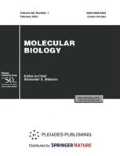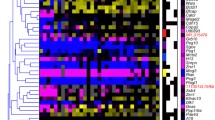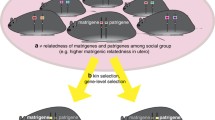Abstract—
Genomic imprinting is an epigenetic phenomenon that differentiates maternal and paternal copies of genes in the genome and causes monoallelic expression depending on parental origin. Imprinting is an evolutionary puzzle, as it bears the costs of diploidization without its advantages, namely, protection from recessive mutations. The aim of this review is to answer the question of why genomic imprinting arose and became fixed in the evolution of angiosperms, insects, marsupials, and placental mammals.


Similar content being viewed by others
REFERENCES
Crouse H.V. 1960. The controlling element in sex chromosome behavior in Sciara. Genetics. 45 (10), 1429–1443.
Singh P.B., Belyakin S.N. 2018. L chromosome behaviour and chromosomal imprinting in Sciara coprophila. Genes (Basel). 9 (9), E440.
Rodrigues J.A., Zilberman D. 2015. Evolution and function of genomic imprinting in plants. Genes. 29 (24), 2517–2531.
Renfree M.B., Hore T.A., Shaw G. 2009. Evolution of genomic imprinting: Insights from marsupials and monotremes. Annu. Rev. Genomics Hum. Genet. 10, 241–262.
Woo H.R., Dittmer T.A., Richards E.J. 2008. Three SRA-domain methylcytosine-binding proteins cooperate to maintain global CpG methylation and epigenetic silencing in Arabidopsis. PLoS Genet. 4 (8), e1000156.
Lindroth A.M., Cao X., Jackson J.P. 2001. Requirement of chromomethylase 3 for maintenance of CpXpG methylation. Science. 292 (5524), 2077–2080.
Cao X., Jacobsen S.E. 2002. Role of the Arabidopsis DRM methyltransferases in de novo DNA methylation and gene silencing. Curr. Biol. 12 (13), 1138–1144.
Han Q., Bartels A., Cheng X., Meyer A., An Y.C., Hsieh T.F., Xiao W. 2019. Epigenetics regulates reproductive development in plants. Plants (Basel). 8 (12), e564.
Cokus S.J., Feng S., Zhang X. 2008. Shotgun bisulphite sequencing of the Arabidopsis genome reveals DNA methylation patterning. Nature. 452 (7184), 215–219.
Gerashchenkov G.A., Yasybaeva G.R., Rozhnova N.A., Chemeris A.V. 2016. Mechanisms of genomic imprinting in flowering plants. Izv. Ufimsk. Nauch. Trentra Ross. Akad. Nauk. 3, 42–52.
Ibarra C.A., Feng X., Schoft V.K., Hsieh T.F., Uzawa R., Rodrigues J.A., Zemach A., Chumak N., Machlicova A., Nishimura T., Rojas D., Fischer R.L., Tamaru H., Zilberman D. 2012. Active DNA demethylation in plant companion cells reinforces transposon methylation in gametes. Science. 337 (6100), 1360–1364.
Jullien P., Susaki D., Yelagandula R. 2012. DNA methylation dynamics during sexual reproduction in Arabidopsis thaliana. Curr. Biol. 22 (19), 1825–1830.
Kohler C., Wolff P., Spillane C. 2012. Epigenetic mechanisms underlying genomic imprinting in plants. Annu. Rev. Plant Biol. 63, 331–352.
Batista R.A., Moreno-Romero J., Qiu Y., van Boven J., Santos-González J., Figueiredo D.D., Köhler C. 2019. The MADS-box transcription factor PHERES1 controls imprinting in the endosperm by binding to domesticated transposons. eLife. 2 (8), e50541.
Schmidt A., Wöhrmann H.J., Raissig M.T., Arand J., Gheyselinck J., Gagliardini V., Heichinger C., Walter J., Grossniklaus U. 2013. The Polycomb group protein MEDEA and the DNA methyltransferase MET1 interact to repress autonomous endosperm development in Arabidopsis. Plant J. 73 (5), 776–787.
Wolf J.B., Brandvain Y. 2014. Gene interactions in the evolution of genomic imprinting. Heredity (Edinb.). 12 (10), e1038.
Morison I.M., Paton C.J., Cleverley S.D. 2001. The imprinted gene and parent-of-origin effect database. Nucleic Acids Res. 29, 275–276. http://otago.ac.nz/IGC.
Gehring M., Satyaki P.R. 2017. Endosperm and imprinting, inextricably linked. Plant Physiol. 173 (1), 143–154.
Tikhonov A.V., Efimova O.A., Pendina A.A., Baranov V.S. 2017. Epigenetic DNA reprogramming in human gametes and preimplantation embryos. Med. Genet. 16 (5), 17–25.
Thamban T., Agarwaal V., Khosla S. 2020. Role of genomic imprinting in mammalian development. J. Biosci. 45, e20.
Sazhenova E.A., Lebedev I.N. 2019. Epigenetic mosaicism in genomic imprinting disorders. Russ. J. Genet. 55 (10), 1196–1207.
Baran Y., Subramaniam M., Biton A. 2015. The landscape of genomic imprinting across diverse adult human tissues. Genome Res. 25 (7), 927–936.
Nishiwaki K., Niikawa N., Ishikawa M. 1997. Polymorphic and tissue-specific imprinting of the human Wilms tumor gene WT1. Jpn. J. Hum. Genet. 42 (1), 205–211.
Kermicle J.L. 1970. Dependence of the R-mottled aleurone phenotype in maize on mode of sexual transmission. Genetics. 66, 69–85.
Tuteja R.1., McKeown P.C., Ryan P., Morgan C.C., Donoghue M.T., Downing T., O’Connell M.J., Spillane C. 2019. Paternally expressed imprinted genes under positive Darwinian selection in Arabidopsis thaliana. Mol. Biol. Evol. 36 (6), 1239–1253.
Ferguson-Smith A.C., Bourc’his D. 2018. The discovery and importance of genomic imprinting.eLife. 7, e42368.
Gehring M. 2019. Epigenetic dynamics during flowering plant reproduction: Evidence for reprogramming? New Phytol. 224 (1), 91–96.
O’Neal E., Willis J.H., Franks R.G. 2016. Disruption of endosperm development is a major cause of hybrid seed inviability between Mimulus guttatus and Mimulus nudatus. New Phytol. 210 (3), 1107–1120.
Kradolfer D., Wolff P., Jiang H., Siretskiy A., Kohler C. 2013. An imprinted gene underlies postzygotic reproductive isolation in Arabidopsis thaliana. Dev. Cell. 26, 525–535.
Klosinska M., Picard C.L., Gehring M. 2016. Conserved imprinting associated with unique epigenetic signatures in the Arabidopsis genus. Nat. Plants. 2, e16145.
Filia A.G., Fenn-Moltu G., Ross L. 2019. No evidence for an intragenomic arms race under paternal genome elimination in Planococcus mealybugs. J. Evol. Biol. 32 (5), 491–504.
Das R.I., Hampton D.D., Jirtle R.L. 2009. Imprinting evolution and human health. Mammal. Genome. 20 (9–10), 563–572.
Wolf J.B., Brandvain Y. 2014. Gene interactions in the evolution of genomic imprinting. Heredity (Edinb.). 12 (10), e1038.
Ostrovsky A.N., Lidgard S., Gordon D.P., Schwaha T., Genikhovich G., Ereskovsky A.V. 2016. Matrotrophy and placentation in invertebrates: A new paradigm. Biol. Rev. Camb. Philos. Soc. 91 (3), 673–711.
McGrath J., Solter D. 1983. Nuclear transplantation in the mouse embryo by microsurgery and cell fusion. Science. 220, 1300–1303.
Surani M.A., Barton S.C., Norris M.L. 1984. Development of reconstituted mouse eggs suggests imprinting of the genome during gametogenesis. Nature. 308, 548–550.
Grafodatskaya D., Choufani S., Basran R. 2017. An update on molecular diagnostic testing of human imprinting disorders. J. Pediatr. Genet. 6 (1), 3–17.
Cassidy F.C., Charalambous M. 2018. Genomic imprinting, growth and maternal–fetal interactions. J. Exp. Biol. 221, jeb164517.
Hemida R., van Doorn H., Fisher R. 2016. A novel genetic mutation in a patient with recurrent biparental complete hydatidiform mole: A brief report. Int. J. Gynecol. Cancer. 26 (7), 1351–1353.
Sazhenova E.A., Lebedev I.N. 2008. Epimutations of the KCNQ1OT1 imprinting center of chromosome 11 in early human embryolethality. Russ. J. Genet. 44 (12), 1394–1399.
Sazhenova E.A., Lebedev I.N. 2010. Epimutations of the PLAGL1 imprinted genes in recurrent pregnancy loss. Med. Genet. 9 (11), 34–39.
Diplas A.I., Lambertini L., Lee M.J. 2009. Differential expression of imprinted genes in normal and IUGR human placentas. Epigenetics. 4 (4), 235–240.
Doria S., Sousa M., Fernandes S., Ramalho C., Brandao O., Matias A., Barros A., Carvalho F. 2010. Gene expression pattern of IGF2, PHLDA2, PEG10 and CDKN1C imprinted genes in spontaneous miscarriages or fetal deaths. Epigenetics. 5 (5), 444–450.
Pliushch G., Schneider E., Weise D., El Hajj N., Tresch A., Seidmann L., Coerdt W., Müller A.M., Zechner U., Haaf T. 2010. Extreme methylation values of imprinted genes in human abortions and stillbirths. Am. J. Pathol. 176 (3), 1084–1090.
Zechner U., Pliushch G., Schneider E., El Hajj N, Tresch A., Shufaro Y., Seidmann L., Coerdt W., Müller A.M., Haaf T. 2010. Quantitative methylation analysis of developmentally important genes in human pregnancy losses after ART and spontaneous conception. Mol. Hum. Reprod. 16 (9), 704–713.
Sazhenova E.A., Nikitina T.V., Skryabin N.A., Minaicheva L.I., Ivanova T.V., Nemtseva T.N., Yur’ev S.Yu., Evtushenko I.D., Lebedev I.N. 2017. Epigenetic status of imprinted genes in placenta during recurrent pregnancy loss. Russ. J. Genet. 53 (3), 364–377
Monk D., Mackay D.J., Eggermann T., Maher E.R., Riccio A. 2019. Genomic imprinting disorders: Lessons on how genome, epigenome and environment interact. Nat. Rev. Genet. 20 (4), 235–248.
Delaval K., Wagschal A., Feil R. 2006. Epigenetic deregulation of imprinting in congenital diseases of aberrant growth. Bioessays. 28 (5), 453–459.
Tucci V., Isles A.R., Kelsey G., Ferguson-Smith A.C. 2019. Genomic imprinting and physiological processes in mammals. Cell. 176 (5), 952–965.
Keverne E.B., Martel F.L., Nevison C.M. 1996. Primate brain evolution: Genetic and functional considerations. Proc. Biol. Sci. 263 (1371), 689–696.
Keverne E.B. 2001. Genomic imprinting and the maternal brain. Prog Brain Res. 133, 279–285.
Chung S.H., Marzban H., Aldinger K., Dixit R., Millen K., Schuurmans C., Hawkes R. 2011. Zac1 plays a key role in the development of specific neuronal subsets in the mouse cerebellum. Neural. Dev. 6, e25.
Peeters R.P., Hernandez A., Ng L., Ma M., Sharlin D.S., Pandey M., Simonds W.F., St Germain D.L., Forrest D. 2013. Cerebellar abnormalities in mice lacking type 3 deiodinase and partial reversal of phenotype by deletion of thyroid hormone receptor α1. Endocrinology. 154 (1), 550–561.
McNamara G.I., Davis B.A., Browne M., Humby T., Dalley J.W., Xia J., John R.M., Isles A.R. 2018. Dopaminergic and behavioural changes in a loss-of-imprinting model of Cdkn1c. Genes Brain Behav. 17 (2), 149–157.
Kuwajima T., Nishimura I., Yoshikawa K. 2006. Necdin promotes GABAergic neuron differentiation in cooperation with Dlx homeodomain proteins. J. Neurosci. 26 (20), 5383–5392.
Cassidy S.B., Schwartz S., Miller J.L., Driscoll D.J. 2012. Prader–Willi syndrome. Genet. Med. 14 (1), 10–26.
Soellner L., Begemann M., Mackay D.J., Grønskov K., Tumer Z., Maher E.R., Temple I.K., Monk D., Riccio A., Linglart A., Netchine I., Eggermann T. 2017. Recent advances in imprinting disorders. Clin. Genet. 91, 3–13.
Perez J.D, Rubinstein N.D., Dulac C. 2016. New perspectives on genomic imprinting, an essential and multifaceted mode of epigenetic control in the developing and adult brain. Annu. Rev. Neurosci. 39, 347–384.
Schulz R., McCole R.B., Woodfine K., Wood A.J., Chahal M., Monk D., Moore G.E., Oakey R.J. 2009. Transcript- and tissue-specific imprinting of a tumour suppressor gene. Hum. Mol. Genet. 18 (1), 118–127.
Thamban T., Sowpati D.T., Pai V., Nithianandam V., Abe T., Shioi G., Mishra R.K., Khosla S. 2019. The putative neuronatin imprint control region is an enhancer that also regulates the Blcap gene. Epigenomics. 11 (3), 251–266.
Zhou Y., Zhang X., Klibanski A. 2012. MEG3 noncoding RNA: A tumor suppressor. J. Mol. Endocrinol. 48 (3), R45–R53.
Lopez S.J., Segal D.J., La Salle J.M. 2019. UBE3A: An E3 ubiquitin ligase with genome-wide impact in neurodevelopmental disease. Front. Mol. Neurosci. 11, e476.
Mishra A., Jana N.R. 2008. Regulation of turnover of tumor suppressor p53 and cell growth by E6-AP, a ubiquitin protein ligase mutated in Angelman mental retardation syndrome. Cell Mol. Life Sci. 65 (4), 656–666.
Chiavegatto S., Sauce B., Ambar G., Cheverud J.M., Peripato A.C. 2012. Hypothalamic expression of Peg3 gene is associated with maternal care differences between SM/J and LG/J mouse strains. Brain Behav. 2 (4), 365–376.
Ineson J., Stayner C., Hazlett J., Slobbe L. 2012. Somatic reactivation of expression of the silent maternal Mest allele and acquisition of normal reproductive behavior in a colony of Peg1/Mest mutant mice. J. Reprod. 58 (4), 490–500.
Keverne E.B. 2011. Epigenetics and brain evolution. Epigenomics. 3 (2), 183–191.
Tunster S.J., Creeth H.D., John R.M. 2016. The imprinted Phlda2 gene modulates a major endocrine compartment of the placenta to regulate placental demands for maternal resources. Dev. Biol. 409 (1), 251–260.
Creeth H.D., McNamara G.I., Tunster S.J., Boque-Sastre R., Allen B., Sumption L., Eddy J.B., Isles A.R., John R.M. 2018. Maternal care boosted by paternal imprinting in mammals. PLoS Biol. 16 (7), e2006599.
Monk D., Arnaud P., Frost J., Hills F.A., Stanier P., Feil R., Moore G.E. 2009. Reciprocal imprinting of human GRB10 in placental trophoblast and brain: Evolutionary conservation of reversed allelic expression. Hum. Mol. Genet. 15 (18), 3066–3074.
Garfield A.S., Cowley M., Smith F.M., Moorwood K., Stewart-Cox J.E., Gilroy K., Baker S., Xia J., Dalley J.W., Hurst L.D., Wilkinson L.S., Isles A.R., Ward A. 2011. Distinct physiological and behavioural functions for parental alleles of imprinted Grb10. Nature. 469 (7331), 534–538.
Rienecker K.D., Chavasse A.T., Moorwood K., Ward A., Isles A.R. 2020. Detailed analysis of paternal knockout Grb10 mice suggests effects on stability of social behavior, rather than social dominance. Genes Brain Behav. 19 (1), e12571.
Portmann-Lanz C.B., Schoeberlein A., Portmann R., Mohr S., Rollini P., Sager R., Surbek D.V. 2010. Turning placenta into brain: Placental mesenchymal stem cells differentiate into neurons and oligodendrocytes. Am. J. Obstet. Gynecol. 202 (3), 294.e1–294.e11.
Keverne E.B. 2014. Significance of epigenetics for understanding brain development, brain evolution and behavior. Neuroscience. 4 (264), 207–217.
Chen X.Y., Xue Y., Wang H., Zhu S.H., Hao X.M., Chen L. 2013. Modulation of firing activity by endogenous GABAA receptors in the globus pallidus of MPTP-treated parkinsonian mice. Neurosci. Bull. 29 (6), 701–707.
Kono T. 2006. Genomic imprinting is a barrier to parthenogenesis in mammals. Cytogenet. Genome Res. 113, 31–35.
Weisstein A.E., Feldman M.W., Spencer H.G. 2002. Evolutionary genetic models of the ovarian time bomb hypothesis for the evolution of genomic imprinting. Genetics. 162, 425–439.
Varmuza S., Mann M. 1994. Genomic imprinting: Defusing the ovarian time bomb. Trends. Genet. 10 (4), 118–123.
Barlow D.P. 1993. Methylation and imprinting: from host defense to gene regulation. Science. 260, 309–310.
Roberts R.M., Green J.A., Schulz L.C. 2016. The evolution of the placenta. Reproduction. 152, R179–R189.
Ono R.I., Nakamura K., Inoue K., Naruse M., Usami T., Wakisaka-Saito N., Hino T., Suzuki-Migishima R., Ogonuki N., Miki H., Kohda T., Ogura A., Yokoyama M., Kaneko-Ishino T., Ishino F. 2006. Deletion of Peg10, an imprinted gene acquired from a retrotransposon, causes early embryonic lethality. Nat. Genet. 38 (1), 101–106.
Henke C., Strissel P.L., Schubert M.T., Mitchell M., Stolt C.C., Faschingbauer F., Beckmann M.W., Strick R. 2015. Selective expression of sense and antisense transcripts of the Sushi-ichi-related retrotransposon-derived family during mouse placentogenesis. Retrovirology. 12, e9.
Kitazawa M., Tamura M., Kaneko-Ishino T., Ishino F. 2017. Severe damage to the placental fetal capillary network causes mid- to late fetal lethality and reduction in placental size in Peg11/Rtl1 KO mice. Genes Cells. 22 (2), 174–188.
Haig D., Graham C. 1991. Genomic imprinting and the strange case of the insulin-like growth factor II receptor. Cell. 64, 1045–1046.
Haig D. 2004. Evolutionary conflicts in pregnancy and calcium metabolism: A review. Placenta. 25, 10–15.
Xiong Y., Mei W., Kim E.D., Mukherjee K., Hassanein H., Barbazuk W.B., Sung S., Kolaczkowski B., Kang B.H. 2014. Adaptive expansion of the maize maternally expressed gene (Meg) family involves changes in expression patterns and protein secondary structures of its members. BMC Plant Biol. 14, e204.
Lan Y., Liu X., Fu Y., Huang S. 2018. Arabidopsis class I formins control membrane-originated actin polymerization at pollen tube tips. PLoS Genet. 14 (11), e1007789.
Funding
This study was supported by the Russian Foundation for Basic Research (project 19-14-50333).
Author information
Authors and Affiliations
Corresponding author
Ethics declarations
The authors declare that they have no conflict of interest.
This article does not contain any research with biological material as an object.
Additional information
Translated by A. Kashevarova
Rights and permissions
About this article
Cite this article
Sazhenova, E.A., Lebedev, I.N. Evolutionary Aspects of Genomic Imprinting. Mol Biol 55, 1–15 (2021). https://doi.org/10.1134/S0026893320060102
Received:
Revised:
Accepted:
Published:
Issue Date:
DOI: https://doi.org/10.1134/S0026893320060102




